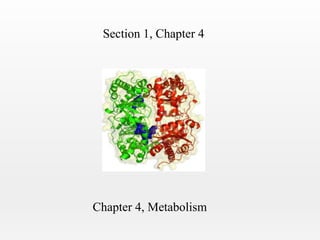
Cellular Metabolism: Anabolic & Catabolic Reactions
- 1. Section 1, Chapter 4 Chapter 4, Metabolism
- 2. Cellular Metabolism metabolism is the sum of all reactions in the body metabolic reactions are of two types Anabolism In anabolic reactions energy is used to synthesize large molecules from smaller molecules. Anabolic reactions create materials for growth and repair. Catabolism In catabolic reactions large molecules are decomposed into smaller molecules Catabolic reactions release energy for cellular use
- 3. Dehydration Synthesis Dehydration synthesis is a type of anabolic reaction. triglycerides, polysaccharides, and proteins are synthesized through dehydration synthesis A molecule of water is released from dehydration synthesis. Amino acids are joined by dehydration synthesis
- 4. Dehydration Synthesis Synthesizes polysaccharides from monosaccharides proteins from amino acids nucleic acids from nucleotides fats by joining fatty acids to glycerol dehydration synthesis
- 5. Hydrolysis hydrolysis is the reverse of dehydration synthesis water is used to break apart molecules hydrolysis releases energy from chemical bonds hydrolysis
- 6. Hydrolysis Decomposes Polysaccharides into monosaccharides & disaccharides Decomposes proteins into amino acids Decomposes Fats into fatty acids & glycerol Decomposes Nucleic Acids into nucleotides
- 8. The critical amount of energy required for a reaction to occur is called the activation energy. Enzymes are biological catalysts They greatly reduce the activation energy required to start a reaction.
- 9. Characteristics of enzymes Most enzymes are Proteins Enzymes lower the activation energy of a reaction Enzymes catalyze reactions – they increase the rate of reactions, but are not consumed by the reaction Enzymes are specific to one substrate. A substrate is the target molecule of an enzyme
- 10. Enzyme Names Enzymes are named for substrate they act upon and their name usually ends with _____ase. Examples of enzymes: Lipase: decomposes lipids Protease: decomposes proteins Nuclease: decomposes nucleic acids ATP Synthase: synthesizes ATP molecules
- 11. Enzymes The Active site of an enzyme is the region that binds to the substrate The enzyme temporarily binds to the substrate forming an Enzyme-Substrate Complex The Enzyme releases the product and enzyme is reused for a new reaction.
- 12. Rate of enzyme-catalyzed reactions The rate of a reaction is limited by: 1. The concentration of substrate 2. The concentration of enzyme 3. The efficiency of enzymes Some enzymes handle 2-3 molecules per second Other enzymes handle thousands per second
- 13. Metabolic Pathways A metabolic pathway is a complex series of reactions leading to a product Metabolic Pathways are controlled by several enzymes Example: The catabolic pathway for the breakdown of glucose is highly complex.
- 14. Metabolic Pathways The product of each reaction becomes the substrate of next reaction. Each step requires its own enzyme The least efficient enzyme is the “Rate-Limiting Enzyme” Rate-limiting enzyme is usually first in sequence • Enzyme A = Rate-limiting Enzyme
- 15. Negative Feedback in Metabolic Pathway Negative feedback prevents too much product from being produced. The product of the metabolic pathway often inhibits the rate-limiting enzyme.
- 16. Cofactor substance that increases the efficiency of an enzyme Cofactors include ions (zinc, iron, copper) and coenzymes Coenzymes are organic cofactors Coenzymes include Vitamins (Vitamin A, B, D) Reusable – required in small amounts
- 17. Vitamins are essential organic molecules that humans cannot synthesize, so they must come from diet Many vitamins are coenzymes Vitamins can function repeatedly, so can be used in small amounts. Example: Coenzyme A
- 18. Energy for Metabolic Reactions Energy: is the capacity to change something, or ability to do work. Common forms of energy: Heat Light Sound Chemical energy Mechanical energy Electrical energy
- 19. Energy cannot be created or destroyed, but it may be transferred from one form to another. example of energy transfer: combustion engine The combustion of fuel converts chemical energy in the gasoline into kinetic energy, heat, sound. Water and CO2 are produced as waste. Fuel (chemical energy) + Oxygen = Kinetic Energy + CO2 + H2O
- 20. Cellular Respiration Cell Respiration is the transfer of energy from food molecules into a form the cells can use Energy from foods such as glucose is used to make ATP for the cell. Reaction of Cell Respiration Initial fuel or energy source End of Section 1, Chapter 4 ATP = Energy currency for cells